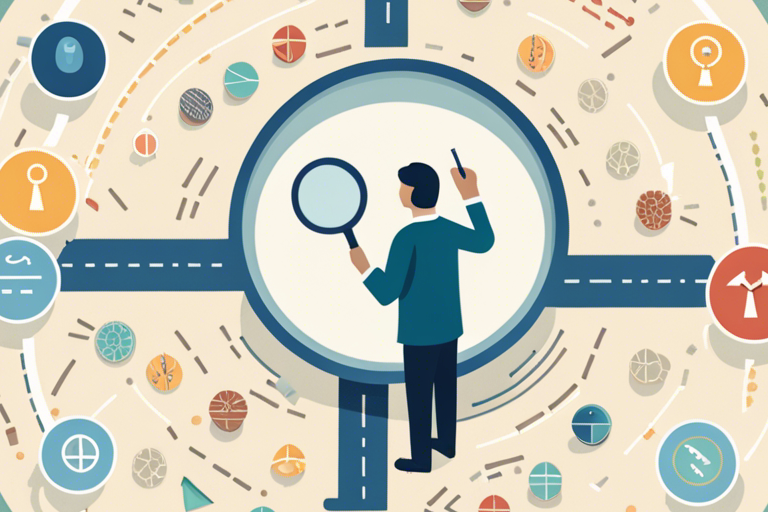Are you tired of feeling overwhelmed when faced with a problem? Do you ever wish you had the skills to approach challenges with confidence and find effective solutions? Look no further, because in this blog, we will delve into problem solving strategies that will transform you into a pro.
In this information-packed article, we will explore a variety of techniques and approaches to help you solve problems more efficiently. We understand that problem solving strategies can be a daunting task, so we will break it down for you, step by step. From identifying the root cause of the problem to brainstorming solutions and evaluating their effectiveness, we’ve got you covered.
Here’s a sneak peek at what you can expect to learn:
The importance of a systematic approach to problem solving strategies
How to define and analyze the problem effectively
Strategies for generating creative and innovative solutions
Tips for evaluating and selecting the best solution
Techniques to overcome obstacles and ensure successful implementation
By the end of this blog, you’ll have a toolbox filled with problem solving strategies that you can apply to any situation. Say goodbye to frustration and hello to confident decision-making.
Short Summmery
Are you tired of feeling overwhelmed when faced with a problem? Do you ever wish you had the skills to approach challenges with confidence and find effective solutions? Look no further, because in this blog, we will delve into problem solving strategies that will transform you into a pro.
In this information-packed article, we will explore a variety of techniques and approaches to help you solve problems more efficiently. We understand that problem solving strategies can be a daunting task, so we will break it down for you, step by step. From identifying the root cause of the problem to brainstorming solutions and evaluating their effectiveness, we’ve got you covered.
Here’s a sneak peek at what you can expect to learn:
The importance of a systematic approach to problem solving strategies
How to define and analyze the problem effectively
Strategies for generating creative and innovative solutions
Tips for evaluating and selecting the best solution
Techniques to overcome obstacles and ensure successful implementation
By the end of this blog, you’ll have a toolbox filled with problem solving strategies that you can apply to any situation. Say goodbye to frustration and hello to confident decision-making.
Short Summmery
- A systematic approach is essential in problem solving strategies to help you approach challenges with confidence and find effective solutions.
- Defining and analyzing the problem effectively is crucial in order to understand its root cause and develop appropriate solutions.
- To tackle problems creatively, it is important to employ strategies that encourage innovative thinking and generate unique solutions.
- Evaluating and selecting the best solution requires a thoughtful assessment of the available options, considering their feasibility and potential outcomes.
- Overcoming obstacles and ensuring successful implementation of the chosen solution is vital for achieving desired results.
- By utilizing these problem solving strategies, you can enhance your decision-making skills and become a pro at solving various challenges.
1. Understanding Problem Solving Strategies
Section: Understanding Problem Solving Strategies
Problem solving is an essential skill that can greatly enhance one’s ability to overcome challenges and achieve success. However, it requires a systematic approach and the utilization of effective strategies. In this section, we will explore the importance of understanding problem solving strategies and how they can make you a pro at tackling various issues.
1. Importance of Problem Solving Strategies
Problem solving strategies provide a structured framework to analyze and resolve complex problems. They help break down the problem into manageable steps, allowing for a more logical and efficient approach.
Understanding various problem solving strategies equips individuals with the necessary tools to navigate through different situations. It enables them to approach problems from different angles, fostering creativity and critical thinking.
Effective problem solving strategies can save time, energy, and resources by guiding individuals towards the most efficient and effective solutions.
2. Recognizing the Problem Solving Process
The problem solving process typically involves several key steps, including problem identification, analysis, generating possible solutions, evaluating alternatives, and implementing the selected solution.
Each step plays a crucial role in the overall problem solving process, and understanding these steps can help individuals approach problem solving with clarity and purpose.
3. Commonly Used Problem Solving Strategies
a. Means-End Analysis: This strategy involves breaking down the problem into sub-problems and identifying the difference between the current state and the desired goal. By bridging this gap systematically, individuals can derive effective solutions.
b. Working Backwards: This strategy entails starting from the desired goal and working backward to the initial problem. It helps individuals identify the necessary steps or actions required to achieve the desired outcome.
c. Trial and Error: This strategy involves trying out different approaches or solutions, learning from mistakes, and making necessary adjustments along the way. It is particularly useful when dealing with complex problems that do not have a clear-cut solution.
d. Brainstorming: Brainstorming encourages the generation of multiple ideas and perspectives, fostering creativity and innovative problem solving. It involves gathering a group of individuals and collectively brainstorming potential solutions.
4. Applying Problem Solving Strategies
To effectively apply problem solving strategies, individuals should:
Clearly define the problem, taking into account all relevant information and constraints.
Break down the problem into smaller, more manageable parts.
Consider different perspectives and explore various potential solutions.
Evaluate the pros and cons of each solution before selecting the most
2. Recognizing the Problem
When it comes to problem solving strategies, the first and most crucial step is recognizing the problem at hand. This involves being able to identify and define the problem clearly and accurately. Here are some effective strategies to help you recognize and understand the problem better:
1. Analyze the Given Information: Start by carefully analyzing the given information or data related to the problem. Look for any patterns, inconsistencies, or clues that can provide insights into the problem’s nature and underlying factors.
2. Break Down the Problem: Sometimes, a problem may seem overwhelming or complex at first glance. To make it more manageable, break it down into smaller, interconnected parts. This will help you gain a better understanding of the problem’s components and how they relate to each other.
3. Conduct a Gap Analysis: Compare the current situation or problem to the desired state or goal. Identify the gaps or differences between the two, as this can give you a clear idea of what needs to be addressed or changed to solve the problem effectively.
4. Consider Similar Problems: Reflect on any similar problems you have encountered in the past or examine how others have approached similar situations. Drawing upon previous experiences or knowledge can provide valuable insights and potential solutions.
5. Use Effective Problem Solving Techniques: Different problem solving strategies techniques can be employed depending on the nature of the problem. Some commonly used techniques include means-end analysis, brainstorming, root cause analysis, and trial-and-error. Select the most appropriate technique that aligns with the problem’s characteristics.
6. Seek Different Perspectives: Sometimes, solving a problem requires fresh perspectives and insights. Engage with others who have a different outlook or expertise in the relevant area. Collaborative problem solving can lead to innovative solutions by considering a wider range of ideas and perspectives.
7. Utilize Resources and Tools: Take advantage of available resources and problem solving tools. This can include reference materials, online research, software programs, or even seeking professional advice. These resources can provide additional information and support your problem solving strategies efforts.
By utilizing these strategies, you can enhance your ability to recognize problems and gain a clear understanding of their underlying factors. This step is crucial for setting the foundation for effective problem solving.
“Recognizing the problem accurately is key to finding an effective solution.”
3. Analyzing the Problem
When it comes to effective problem solving, one crucial step is analyzing the problem at hand. This step helps you gain a deeper understanding of the problem, identify its root causes, and develop a clearer path towards finding a solution.
1. Identifying the Key Elements:
To start the analysis, break down the problem into its key elements. Look for any given information or constraints that are relevant to the problem. Identify the main variables, factors, or conditions that contribute to the problem.
2. Recognizing Specific Patterns or Trends:
Observe the problem carefully to recognize any specific patterns or trends that can provide insights. Look for recurring themes, common scenarios, or variations of the problem that may help you recognize similarities or underlying causes.
Quote: “Effective problem solving requires a systematic approach to analyzing the problem. Taking the time to recognize specific patterns or trends can lead to valuable insights that guide your problem solving strategy.” Dr. Amy David, Problem Solving Expert
3. Conducting Gap Analysis:
Compare the current state or situation to the desired outcome or goal. Identify the gaps or discrepancies that exist between the two. This analysis helps you pinpoint the areas that require attention and improvement.
List of Useful Problem Solving Strategies:
Means-End Analysis: Break down the problem into smaller sub-problems and identify the steps needed to bridge the gap between the current state and the desired goal.
Decomposition: Divide a complex problem into smaller, more manageable parts to gain a better understanding of each component.
Follow Instructions: When faced with a problem that has clear instructions or guidelines, carefully follow them to ensure accuracy and effectiveness.
Creative Thinking: Engage in brainstorming or creative problem solving strategies techniques to generate alternative perspectives, ideas, and potential solutions.
Quote: “Creative problem solvers think outside the box and explore unconventional approaches. This willingness to challenge traditional thinking can lead to breakthrough solutions.” Professor John Williams, Problem Solving strategies Expert
4. Taking Note of Assumptions:
Be aware of any assumptions or preconceived notions you may have about the problem. Question them and evaluate if they are valid or if they might hinder your problem solving strategies process.
💡 key Takeaway: Analyzing the problem is a crucial step in effective problem solving. By breaking down the problem, recognizing patterns, conducting gap analysis, and challenging assumptions, you can gain valuable insights that guide your problem solving strategy. It allows you to understand the problem more deeply, identify relevant information, and set
4. Generating Creative Solutions
When it comes to problem solving strategies, thinking outside the box and generating creative solutions can be highly beneficial. This section will explore some effective strategies to help you become a pro at generating innovative solutions.
1. Embrace Divergent Thinking:
Divergent thinking involves exploring multiple possibilities and generating numerous ideas. Allow yourself to think freely and come up with as many potential solutions as possible. Don’t worry about feasibility at this stage; focus on quantity rather than quality. The goal is to expand your options and encourage creative thinking.
2. Use Mind Mapping Techniques:
Mind mapping is an excellent tool for organizing your thoughts and visually mapping out potential solutions. Start with the problem statement in the center of the mind map and branch out with different ideas and possible solutions. This technique helps to uncover connections, reveal patterns, and stimulate creativity.
3. Dissect the Problem:
Break down the problem into its core components and analyze each element individually. By identifying the underlying factors, you can approach the problem from different angles and find unique solutions. Consider conducting a gap analysis to identify the differences between the desired outcome and the current situation. This analysis can prompt creative ideas that bridge the gap effectively.
4. Seek Inspiration from Different Sources:
Expose yourself to diverse sources of inspiration, such as books, articles, art, nature, or even conversations with others. Draw inspiration from unrelated fields or industries to discover fresh perspectives and innovative approaches to problem solving. Sometimes, a solution from a completely different domain can be applied to your specific problem with minor adaptations.
Remember the words of Thomas Edison, who said, “To have a great idea, have a lot of them.” Don’t shy away from brainstorming and embracing unconventional solutions. Creative problem solving strategies often involves thinking beyond the obvious.
💡 key Takeaway: In problem solving strategies, generating creative solutions is essential for finding innovative answers. By embracing divergent thinking, using mind mapping techniques, dissecting the problem, and seeking inspiration from various sources, you can enhance your ability to find unique and effective solutions.
5. Evaluating and Choosing the Best Solution
In problem solving strategies, it is not enough to come up with potential solutions, as the ultimate goal is to find the best one. Evaluating and choosing the most effective solution requires careful consideration and analysis of each option. Here are some steps to help you navigate this process:
1. Evaluate the Feasibility (given information, different solution):
Consider the practicality and viability of each solution. Assess whether the solution aligns with the given information and if it is a distinct alternative from other options. Look for a solution that addresses the problem effectively and provides a unique approach.
2. Analyze the Potential Risks (gap analysis, complex problem solving):
Identify and evaluate the risks associated with each solution. Consider the potential drawbacks, challenges, or setbacks that may arise. When addressing complex problems, it is crucial to anticipate any potential obstacles that could hinder the implementation of certain solutions.
3. Compare the Advantages and Disadvantages (list of some very useful problem solving strategy, creative person):
Create a list of the advantages and disadvantages of each solution. Consider the positive and negative aspects of each option. This will enable you to make an informed decision based on the strengths and weaknesses of each potential solution.
4. Seek Input from Others (recognition of specific problem solving strategy):
Consult with colleagues, experts, or stakeholders who can provide valuable insights and alternative perspectives. Their input can help identify blind spots or offer suggestions that you may not have considered. Collaboration often leads to better decision-making and more effective problem solving strategies.
5. Assess the Long-Term Implications (business problem solving strategies method, needs of their customer):
Consider the long-term effects of each proposed solution. Evaluate how the solution aligns with the needs of your business or customers. Assess whether it will have a positive impact in the future or if it could potentially create new problems down the line.
6. Select the Optimal Solution (problem solving, effective problem solving strategy):
Based on the evaluation and analysis performed, choose the solution that offers the most effective and efficient resolution to the problem at hand. Select the solution that maximizes desired outcomes while minimizing potential risks and drawbacks.
By following these steps, you can evaluate and choose the best solution that addresses the problem effectively and efficiently.
💡 key Takeaway: Evaluating and choosing the best solution is a critical step in effective problem solving strategies. It involves evaluating feasibility, analyzing potential risks, comparing advantages and disadvantages, seeking
6. Implementing the Chosen Solution
Once you have analyzed the problem, identified potential strategies, and selected the most effective solution, it’s time to put that solution into action. The implementation phase is a crucial step in the problem solving strategies process, as it determines whether your efforts will lead to the desired outcome. Here’s a comprehensive guide on how to successfully implement the chosen solution.
1. Develop a Plan of Action
Before jumping into implementation, outline a clear plan of action. Break down the solution into smaller, manageable steps that need to be taken. Assign responsibilities to team members if working in a group, or outline your own tasks if working individually. This plan will serve as a roadmap to guide you through the process and help ensure that everything is executed smoothly.
2. Set Realistic Goals and Deadlines
Establish specific and measurable goals for each step of the implementation plan. These goals should be realistic, considering the available resources and constraints. Additionally, set deadlines to keep yourself or your team on track. Having well-defined objectives and deadlines helps maintain focus and motivation throughout the implementation process.
3. Communicate and Coordinate
Effective communication is key during implementation. Share the plan of action with team members, stakeholders, or anyone else involved in the process. Clearly communicate each individual’s responsibilities and ensure everyone understands their role. Regularly update and coordinate with all relevant parties to address any challenges or changes that may arise.
4. Monitor Progress
Keep a close eye on progress to ensure the chosen solution is being implemented correctly and on schedule. Regularly assess and track the success of each step against the established goals. If any deviations or roadblocks are identified, address them promptly and make necessary adjustments to stay on track.
5. Adapt and Iterate
Sometimes, despite careful planning, unexpected obstacles can arise during implementation. It is crucial to be flexible and open to adapting your approach as needed. Monitor the effectiveness of the implemented solution and be prepared to make adjustments or take alternative approaches if required. Embrace a growth mindset that sees challenges as opportunities for learning and improvement.
6. Evaluate the Outcome
Once the implementation is complete, it’s essential to evaluate the outcome. Assess whether the chosen solution has effectively addressed the initial problem and achieved the desired results. Analyze the impact of the implemented solution and gather feedback from relevant stakeholders. This evaluation will provide insights for future problem solving strategies endeavors and allow for continuous improvement.
💡 key Takeaway: Implementing the chosen solution requires careful planning, effective communication, monitoring progress, flexibility
Conclusion
In conclusion, incorporating these problem solving strategies into your daily life will elevate your skills to professional levels. By adopting a proactive mindset and adhering to clear problem solving strategies frameworks, you’ll be well-equipped to tackle challenges head-on and achieve success. Remember to start by fully understanding the problem at hand, breaking it down into manageable parts, and exploring various solutions. Embrace creativity and think outside the box, as innovative approaches often lead to breakthroughs.
Additionally, cultivating effective communication and collaboration skills will help you navigate through complex problem solving situations with ease. Stay informed and up-to-date with the latest developments and trends in your field to continuously improve your problem solving abilities. To put these strategies into action, commit to developing a problem solving strategies routine. Prioritize
FAQ
How do you identify a problem?
The first step in problem solving is to identify the problem. This can be done by asking questions, gathering information, and analyzing the situation. Some common questions to ask include: What is the issue? What caused it? Who is affected by it? What are the potential consequences? Once the problem is identified, you can then move on to finding a solution.
What are problem solving strategies?
Problem solving strategies are logical and systematic approaches used to find solutions to complex problems. These strategies involve breaking down a problem into smaller, more manageable parts, analyzing and evaluating potential solutions, and implementing a plan to solve the problem. Some common problem solving strategies include trial and error, brainstorming, and using algorithms or heuristics.
These strategies can be applied to a wide range of problems, from personal dilemmas to complex business challenges. By developing and using effective problem solving strategies, individuals can become more efficient and successful problem solvers in all aspects of their lives.
How do I evaluate and choose the best solution?
When evaluating and choosing the best solution, it is important to consider a few key factors. First, assess the feasibility of each solution is it realistic and achievable? Next, consider the potential impact of each solution will it effectively solve the problem? Additionally, think about the resources and time required for each solution. Finally, it can be helpful to gather feedback from others and weigh their opinions. Ultimately, the best solution will be one that is practical, effective, and aligns with your goals and values.
How do you analyze a problem?
To effectively analyze a problem, you can follow these steps: Define the problem clearly and specifically. Gather all the necessary information and data related to the problem. Break down the problem into smaller, more manageable parts. Identify any patterns or commonalities among the data. Brainstorm potential solutions or strategies. Evaluate the potential solutions and choose the most effective one. Implement the solution and monitor its effectiveness. Make adjustments as needed.
What are some tips for implementing a solution effectively?
Clearly define the problem: Make sure you understand the problem fully before attempting to solve it. This will prevent wasting time and effort on the wrong solution. Break it down: If the problem seems overwhelming, break it down into smaller, more manageable parts. This will make it easier to identify the root cause and come up with a solution. Brainstorm multiple solutions: Don’t settle for the first solution that comes to mind.
Take the time to brainstorm and come up with multiple potential solutions. This will increase the chances of finding the most effective one. Analyze the pros and cons: Once you have a list of potential solutions, analyze the pros and cons of each. This will help you determine which solution is the most practical and feasible. 5.
How can I come up with creative solutions?
Here are some strategies for coming up with creative solutions to problems: Brainstorming: This involves generating as many ideas as possible, without judgement or criticism. It allows for out-of-the-box thinking and can lead to unexpected solutions.
Mind mapping: This is a visual tool that helps to organize and connect ideas. It can help to see different perspectives and connections that may lead to a creative solution. Reverse thinking: Instead of approaching a problem from a traditional perspective, try thinking about it in reverse. This can help to break out of established patterns and find new solutions. Analogies: Comparing the problem to something unrelated can spark new ideas and perspectives.







